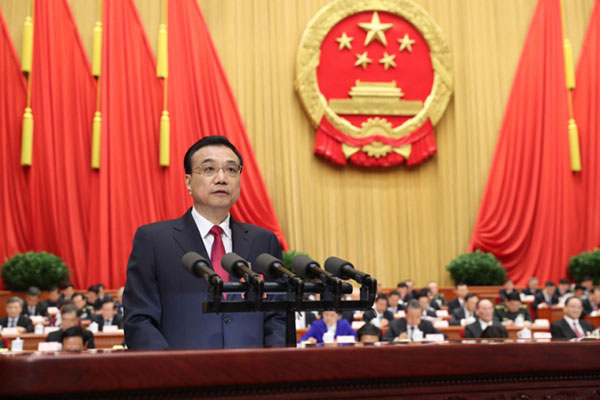
Premier Li delivers the government work report in the Great Hall of the People, March 5, 2017.
On March 5, Premier Li Keqiang delivered the government work report before the opening of the annual session of China’s top legislature, the National People’s Congress (NPC), and for the first time, he put smart manufacturing at the top of the country’s development.
It was not the first time Premier Li mentioned “Made in China” in a government work report. Manufacturing has been mentioned in reports in recent years:
March 5, 2017
Endeavor to transform and upgrade traditional industries.
Intensify efforts to implement the Made in China 2025 initiative, promote accelerated applications of big data, cloud computing and Internet of Things, and use new technologies, new forms of business and models to bring about transformation in the production, management and marketing models of traditional industries.
With the development of smart manufacturing as our focus, the government will press ahead with building national smart manufacturing demonstration zones and manufacturing innovation centers. Work hard on the implementation of projects to build a robust foundation for industrial development and projects to develop and make major equipment, and make a big push to develop advanced manufacturing, thus moving forward mid- and high-end manufacturing.
Improve policies designed to turn China into a manufacturer of quality, and adopt a variety of support measures for technological upgrading.
March 5, 2016
Work to upgrade manufacturing. Intensify efforts to promote the integrated development of Made in China 2025 and the Internet Plus action plan; build national platforms for innovation in manufacturing; carry out demonstration programs in smart manufacturing; launch projects to build a more solid foundation for industry development, promote green manufacturing, and develop high-end equipment, and carry out major technological transformation and upgrading initiatives.
Promote greater use of Chinese equipment, technology, standards, and services in the international market, and help Chinese manufacturing brands gain international recognition.
Continue to relax market access restrictions on investment, further open the service sector and the general manufacturing sector, simplify procedures for establishing companies with overseas investment, and step up efforts to attract more investment.
Work to see that energy-saving renovations in buildings are strengthened and efforts are accelerated to make traditional manufacturing more eco-friendly.
March 5, 2015
Revise the Catalogue for the Guidance of Industries for Foreign Investment. Focus on making the service and manufacturing sectors even more open by halving the number of industries in which foreign investment is restricted.
Manufacturing is traditionally a strong industry for China. Implement the “Made in China 2025” strategy; seek innovation-driven development; apply smart technologies; strengthen foundations; pursue green development, and redouble our efforts to upgrade China from a manufacturer of quantity to one of quality.
Provide subsidies and accelerate equipment depreciation to push forward the technological upgrading of traditional industries.
Promote the extensive application of information technologies in industrialization, develop and utilize networking, digitalization, and smart technologies, and work to develop certain key areas first and make breakthroughs in these areas.
Emerging industries and new types of businesses are areas of intense competition.
Launch major projects to develop high-end equipment, information networks, integrated circuits, new energy, new materials, biomedicines, aero engines, and gas turbines, helping emerging industries to become leading industries.
Develop the “Internet Plus” action plan to integrate mobile Internet, cloud computing, big data, and the Internet of Things with modern manufacturing, to encourage the development of e-commerce, industrial networks, and internet banking, and to guide internet-based companies to increase their presence in the international market.
In addition to the 40 billion yuan government fund already in place for investment in China’s emerging industries, more funds need to be raised for promoting business development and innovation.
March 5, 2014
Guide the transformation and upgrading of processing trade, support businesses in creating Chinese brands and developing international marketing networks, develop service trade and undertake services outsourced by other countries, and raise the position of Chinese manufacturing in the global division of labor.
Encourage the export of complete sets of large equipment including telecommunications equipment, railway equipment, and power stations, and enhance the international reputation of Chinese equipment.
Promote full integration of IT application with industrialization, encourage businesses to accelerate technological upgrading, make management more precise, improve the policy for accelerating equipment depreciation, and make traditional industries more competitive.
Build a platform for supporting business startups and innovation in emerging industries.
Strive to catch up with and overtake advanced countries in areas of new-generation mobile communications, integrated circuits, big data, advanced manufacturing, new energy and new materials, and to guide the development of emerging industries.
